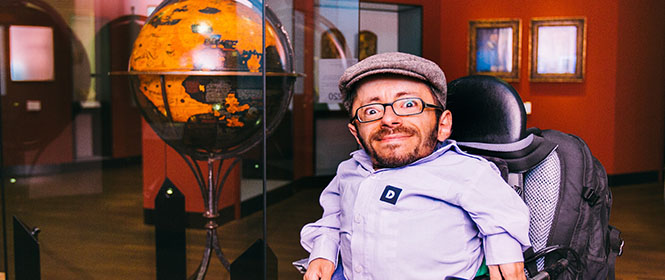
‘THE GLOBE WAS ONE OF THE FIRST-EVER CROWDSOURCING PROJECTS’
My favourite piece of history: Raúl Krauthausen
My favourite piece of history at Deutsches Historisches Museum is a copy of the Behaim Globe from 1492. It is the oldest surviving representation of the earth in globe form. I find it interesting that a crucial part of the world – the American continent – is missing.
I know a bit about incomplete maps. I am one of the founders of Wheelmap, an online global map of wheelchair-friendly places. Users can indicate whether public places, such as cafes and restaurants, are accessible to wheelchair users. The map is growing all the time and is therefore always incomplete. But just like the Behaim Globe, it enables people to share with others what has already been discovered.
WE ALSO WANT TO ENCOURAGE EXPLORATION
I read somewhere that the Behaim Globe aimed to encourage merchants to embark on their own maritime voyages. I see a strong connection with Wheelmap. We also want to encourage people to continue exploring and discovering. Just as people were forever in search of new shores, we never stop looking for new places that are accessible to wheelchair users.
Nobody can make a project like Wheelmap happen on their own, which is why we harness the power of crowdsourcing. Our map is the result of the posts contributed by tens of thousands of users all over the world. I think that the Behaim Globe was one of the first-ever crowdsourcing projects. Although it is named after just one man, the Nuremberg cloth merchant Martin Behaim, it was made by numerous craftsmen who, in turn, drew on the knowledge of countless seafarers, cartographers and thinkers.
WHEELMAP DOES NOT BELONG IN A MUSEUM
It must have been an uplifting feeling for these people to help others find their way in the world. This is also something that motivates me, as I want to empower people to discover their planet.
When I look at the Globe, I often wonder whether its creators knew that it would one day be in a museum. Wheelmap will probably never end up in a museum. It is, after all, a little bit too big. In fact, it’s not even where we want to be. As such a superb objet d’art, the Globe was probably only accessible to a select elite. We, on the other hand, want to create an everyday product that anyone can use. If enough people get involved, our Wheelmap may also be complete one day – just like the globes of the modern era.